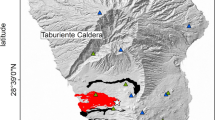Abstract
THE East Pacific Rise at 12°50' N (Fig. 1) is a fast-spreading ridge with intense hydrothermal activity1, and ophiolite studies2and thermal modelling3 indicate that this is a likely setting for a magma chamber. A recent seismic-reflection experiment4 imaged the top of the magma chamber at this site, at a depth of 1.4 km below the sea floor, and found that it is continuous for tens of kilometres along the rise axis. Here we examine a large set of accurate P-wave travel times from a detailed seismic refraction experiment at the same site5. The patterns observed in the travel times demonstrate that a zone of low seismic velocities exists beneath the rise axis throughout the region studied. The best-fitting two-dimensional structure, obtained from linear inversion of the travel times, includes an axial low-velocity zone (magma chamber) only ∼6 km wide, in which velocities are depressed by more than 0.5 km s-1
This is a preview of subscription content, access via your institution
Access options
Subscribe to this journal
Receive 51 print issues and online access
$199.00 per year
only $3.90 per issue
Buy this article
- Purchase on Springer Link
- Instant access to full article PDF
Prices may be subject to local taxes which are calculated during checkout
Similar content being viewed by others
References
Hekinian, R. et al. Mar. geophys. Res. 6, 1–14 (1983).
Pallister, J. S. & Hopson, C. A. J. geophys. Res. 86, 2593–2644 (1981).
Morton, J. L. & Sleep, N. H. J. geophys. Res. 90, 11345–11353 (1985).
Detrick, R. S. et al. Nature 326, 35–41 (1987).
McClain, J. S., Orcutt, J. A. & Burnett, M. J. geophys. Res. 90, 8627–8639 (1985).
Orcutt, J. A., McClain, J. S. & Burnett, M. in Ophiolites and Oceanic Lithosphere 7–16 (Blackwell, Oxford, 1984).
Burnett, M. S., Orcutt, J. A. & Olson, A. H. Geophys. Res. Lett. 15, 1487–1490 (1988).
Rosendahl, B. R. et al. J. geophys. Res. 81, 5294–5304 (1976).
Macdonald, K. C. A. Rev. Earth planet. Sci. 10, 155–190 (1982).
Spudich, P. & Orcutt, J. A. J. geophys. Res. 85, 1409–1433 (1980).
Anderson, R. N. et al. Nature 300, 589–594 (1982).
Macdonald, K. C. et al. Nature 335, 217–225 (1988).
Backus, G. E. J. geophys. Res. 70, 3429–3439 (1965).
Shearer, P. M. & Orcutt, J. A. Geophys. J. R. astr. Soc. 87, 967–1003 (1986).
Olson, A. H. Phys. Earth planet. Inter. 47, 333–345 (1987).
Harding, A. J. et al. J. geophys. Res. (in the press).
Author information
Authors and Affiliations
Rights and permissions
About this article
Cite this article
Burnett, M., Caress, D. & Orcutt, J. Tomographic image of the magma chamber at 12°50' N on the East Pacific Rise. Nature 339, 206–208 (1989). https://doi.org/10.1038/339206a0
Received:
Accepted:
Issue Date:
DOI: https://doi.org/10.1038/339206a0
This article is cited by
-
Is the ocean floor a fractal?
Mathematical Geology (1995)
-
Structure of the Northern Symmetrical Segment of the Juan de Fuca Ridge
Marine Geophysical Researches (1993)
-
Slimline magma chambers
Nature (1992)
-
Relationship between spreading rate and the seismic structure of mid-ocean ridges
Nature (1992)
-
The East Pacific Rise and its flanks 8?18� N: History of segmentation, propagation and spreading direction based on SeaMARC II and Sea Beam studies
Marine Geophysical Researches (1992)
Comments
By submitting a comment you agree to abide by our Terms and Community Guidelines. If you find something abusive or that does not comply with our terms or guidelines please flag it as inappropriate.



